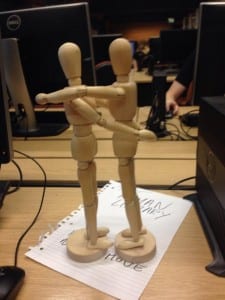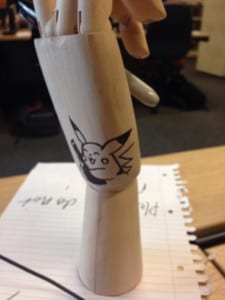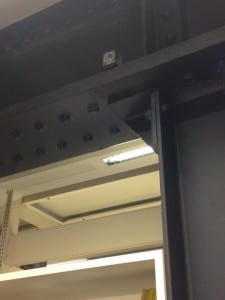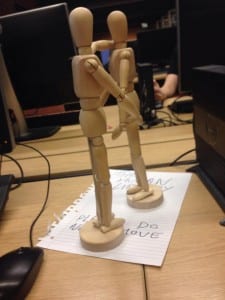OPENING
My Performance, The Human Library, was a guided audio tour that featured interactive elements that took my audience around the Library to experience a series of memories and events that occurred within specific locations of the Library itself. The aims of my performance were simple: I wanted to generate a small community of visitors to the Library whom all share a unique and interesting perspective on what the Library is and where its character truly comes from. In order to accomplish this I acquired or generated 10 different memories, some fake and some real, that took place in a specific location of the Library and would hope to alter my audience’s perspective on that particular location.
The audience for my performance were friends, other students, and faculty members whom I personally invited to experience my tour around the library, and share in this community that I was generating through my performance. I considered initially opening my performance to the public by creating my performance in two dimensional virtual space and having a guided tour online that could be accessed by anyone, but ultimately turned away from this idea due to multiple reasons.
When undertaking research for this performance, I looked at one performance in particular: Punchdrunk Theatre’s Against Captains Orders: A Journey into the Uncharted (Punchdrunk.com, n.d.), as I was intrigued by their usage of a promenade exploration of space within the exhibition to tell the stories that they had located around the Site they used. I felt that this style of tour around a site would translate perfectly to the Library and the concept I wanted to go with (human experiences and memories across the different floors that build upon the character of the Library and further adorn it).
Another Site Specific Performer that I looked at for inspiration when generating my ideas were the works of Marina Abarmaovic and her work on being present in the space. I like Marina’s work and ideology behind her performances, yet initially struggled translating her practices into my own work. In the end, I managed to find a way to use her concept of being present in the space by writing the audio tour in such a way that my audience, as they listen to the story, are encouraged to feel themselves as if they were in the space as well. I feel that this added a more personal depth to my performance and allowed my audiences to truly experience the core values behind my piece and allow themselves to become a part of the community the performance was generating more willingly.
In my personal studies I found multiple articles that debated on the idea of character in a building. The Building Conservation website has this to say on the concept of character in architecture
“Not only is it hard to define but it shares with related concepts such as integrity and honesty, a family resemblance by employing what Ruskin termed ‘the pathetic fallacy’. That is to say we apply concepts properly belonging to human beings to inanimate objects. Can a building really be ‘compromised,’ its ‘integrity’ questioned, its ‘character’ altered?”
(Holder, 2001)
The question posed here is one that helped me to generate my final idea; the question of whether a building can really host a character or even have it be experienced by others. I feel that my performance helped to provide one of a multitude of answers to this question by allowing my audience to experience the memories shared within the Library and build their own perception of the building from that, thus generating a unique character of the Library that each of my audience members would begin to perceive.
Lastly, the key inspiration to my performance was from my own experiences with the site. I personally have had multiple unique and interesting experiences within the Library myself and used these as a basis for generating the rest of my stories and memories for my piece, in hopes that I could create a community around my performance who see the Library as I do.
MY PROCESS AS THE ARTIST
Initially, I began my idea as a virtual concept, one where my audience would experience the memory oriented tour of the Library in a virtual recreation of the building that they would access and explore online. This idea was inspired by virtual tours that I have experienced online, such as the National Gallery Online 360 Degree Virtual Tour (Nationalgallery.org.uk, n.d.). I ultimately abandoned this idea due to many different reasons; one such reason was that I felt that my audience wouldn’t be as connected with the Site online as they would be should they experience the Site in person and the memories first-hand. Another reason is that I felt this would detract from some of the sensory notes I wanted to put across in my performance such as atmosphere and smell. Whilst there are benefits to the removal of these sensory aspects of the performance (such as room to expand on the visual and auditory experience of the tour), I felt that atmosphere was a key feature of the Library that I didn’t want to subtract from my audience’s experience.
After abandoning the concept of a virtual tour around the Library, I spent some time focusing on a purely auditory tour of the Library and reached the same conclusion as before; the experience of the Library loses something if the atmosphere and other senses are taken away. I eventually reached the conclusion that my tour of the Library had to take place within the Library to best represent each of these senses accurately. My concept changed from a virtual one, to a tangible one, wherein my audience would be taken on an actual physical tour of the library guided by myself in voice alone with no physical presence. Taking inspiration from a small Site Specific Performance called Running on Air wherein “[The performer] takes the audience on a journey from Lands End to Edinburgh” (Theatre-wales.co.uk, 2011), I adopted the concept of taking my audience on a journey and the tour became more of an adventure than a simple whistle-stop tour of the Library.
During the development of my idea of turning the tour into a journey, I began to toy with the idea of including props representative of the experiences being relayed to my audience that my audience could interact with to add a sense of change to my piece. I wanted my audience to come away from the performance feeling a sense of permanence within the Library; like they had changed something for the rest of its existence. The first props I decided to test out in my performance were the two mannequins to represent the couple who met at the Library (see fig.1). Upon allowing myself some time with the site, the props, and the audio, I was able to visualise how the inclusion of props would allow my audience to interact with the piece on a further level and generate their own sense of permanence within the site.
Fig.1: Group Room 2 couple (Natalie O’Connell, 2016)
Another aspect of my performance that changed since initial development was the time frame for my piece. I initially wanted The Human Library to be on between the hours of 9am and 5pm on Thursday 5th of May. I soon changed this idea when I realised that setting a timeframe would be restricting the number of people who could experience my performance, so I decided that due to how open I wanted my performance to be I would host The Human Library from the beginning of Thursday to the end of Friday, utilising the entirety of the allotted times for our Site performances. This allowed my audience to show up to the piece at any time and experience the Library on their own time, not rushed or at a time of day that is unsuitable to them.
With the idea of community taking a centre place within my performance, I wanted to begin focusing on the details of this concept. I initially wanted to have an open audience with my virtual performance, but as the idea changed and the space became intransient to the commonplace public, I decided to focus on a small community that I could generate through my site piece. Members of this small community however would be from all different walks of life within the Library; staff, students and lecturers would be invited to experience my performance and take part in the community I was attempting to generate. Work I looked at in my research regarding the concept of community in Site Specific Performances included work by Willi Dorner, who utilised dance troops to explore urban spaces across cityscapes. Whilst this may not be the most obvious link with community in Site Specific Performance, I was inspired by the shapes that the performers managed to create in compact places, working as a unit to create something in a space that went mostly unexplored. I wanted to create a community who had also worked together but without knowing it to build a group of people who had explored a space in a way many had not before.
With my idea beginning to take place I moved into exploring the space on my own to determine where the stories and memories could take place and which ones would be best to use in my final performance. In the end, I settled on ten different stories and experiences (one for every two years that the Library has been a library) that would utilise either a prop representative of the experience, or a specific area that could be explored by my audience. In doing this, I hoped to create a more personal link between the audience and the performance/site that was stronger than them just visiting the locations. In the audio tour, I began to ask my audience to do simple things: take a photograph of the location they’re in, manipulate the props as they saw fit according to the story, or explore the space in their own time. I feel that this was a step in the right direction for my performance, as it strengthened the concept of permanence and helped my audience to feel more attached to the site and their bond to one another.
The next thing I began to develop was what props and what locations would be attached to which specific stories, experiences, or memories. For some, I chose to use props representative of the story that I would bring in from outside of the Library for my audience to manipulate. These included the two mannequins that were previously mentioned (see fig.1 above and 2 below) and three others: a wooden hand, a box that held the answer, and a pair of handcuffs attached to a book collection trolley (see fig.3 and 4 below). As I began to reflect on the nature of these props I decided that it was best to try and come up with more creative ways for my audience to change the models, echoing community street art and its site permanence.

Fig.2: Group Room 2 Couple – Interacted (Natalie O’Connell, 2016)

Fig.3: Loyalty Story – Interacted (Natalie O’Connell, 2016)

Fig.4: The Answer to Life – Discovered (Natalie O’Connell, 2016)
As seen in figure 3, I toyed with the idea of allowing my audience to brand and shift the performance in their own way, altering the state of being of some of the props in The Human Library whilst still retaining the link to the memory or story being relayed to them on the audio tour. I found that this strengthened the sense of community that my audience had with one another, as they began to further improve an artistic installation together rather than just observing it.
In the final weeks of development I spent a lot of time reflecting on my ideas and the process I had taken to get this far. I wanted my audience to feel like they too, had been taken on a journey that would open their eyes to a new Library, a more personal Library. A Library not of books, but of us. It was in the final few weeks of reflection that I looked back and attempted to decipher a title or a name for my project, taking in the ultimate goal of my project, the narrative of my project and what it is that my project focused on. Eventually I found one, The Human Library, that I believed would best represent exactly what my performance was about and what my audience could expect without giving too much information away so as to either turn cynical audience members away or give away the journey’s end before it even began.
REFLECTIONS ON THE PERFORMANCE
My final performance went extremely well, in my opinion. In terms of audience, I believe I managed to attain around 8 different audience members who visited the installation over the two days. This is a smaller audience than I would have liked, but I feel like it was within the right size for how long my performance lasted and I feel like a larger audience of around 30 would have only struggled to get around the performance and interact with all of the props within the two day time span. Upon interviewing my audience I was met with strong, positive feedback and most, if not all, said that they too had begun to see the Library in a different light after partaking in the audio tour. This was exactly what I wanted my audience to feel after having partook in my performance, I wanted their perspectives to be changed and I felt like this was achieved perfectly through the memories and experiences I had selected to relay to them.
Upon reflection of what worked and didn’t work in my performance, I realised there were a few things that I could have polished or put more time and effort into to help maintain a professional polished performance. For example: the models and props were at risk of being stolen within the Library as they weren’t under constant supervision. In order to prevent them being moved or taken away, I had placed them on sheets of paper with the name of the performance a ‘please do not move’ notice on them. I feel like this let some aspects of the performance down as it wasn’t properly thought through and took away from some of the aesthetic appeal of the models in the Library. If I were to do my performance again, I would not use this same method of security and instead spend more time thinking of a way to maintain surveillance on my props.
Something else that I began to think on after the performance had ended was whether or not my performance could remain permanently at the Library with some editing. I think that this would be a great idea and would help my performance to generate an even larger community of people who see the Library as something other than a building with books and computers, yet in order to accomplish this I would most likely have to remove the concept of foreign props in the Library as they would be an obstruction if they remained in the Library permanently. I could attempt to retain the same level of personal interactivity by using the Site as a prop itself as I have done with a few of my initial memories and experiences my audience visited in the tour, which would both help retain the sense of audience permanence and continue to generate a strengthened community bond.
Over the course of the module I feel like my engagement with Site Specific Performance has been one that has been heavily influenced by the methods and practices of other performers (such as Punchdrunk Theatre and Marina Abramovic), yet has also been fuelled by my own experiences and instinct when it came to the Site. I believe that the core principles for my performance stemmed from my own perception of the Library, but upon research of the techniques and performances mentioned by the influences I had in this blog post, I was able to better construct a performance that enabled me to reach my goals for this performance. Methods and practices such as Abramovic’s concept of being present in the art and Punchdrunk Theatre’s promenade exploration of Site have helped me immensely in developing my base idea and generating the community around my site through personal connections with the building where my performance took place.
2756 words
Bibliography
Punchdrunk.com. (n.d.). Punchdrunk. [online] Available at: http://punchdrunk.com/past-shows/article/against-captains-orders [Accessed 11 May 2016].
Nationalgallery.org.uk. (n.d.). Virtual tour | Visiting | National Gallery, London. [online] Available at: https://www.nationalgallery.org.uk/visiting/virtualtour/#/central-hall/ [Accessed 12 May 2016].
Theatre-wales.co.uk. (2011). RUNNING ON AIR – News and latest information on Theatre Dance and Performance in Wales – news, reviews, commentary, features and discussion. [online] Available at: http://www.theatre-wales.co.uk/news/newsdetail.asp?newsID=4027 [Accessed 11 May 2016].
Holder, J. (2001). The Character of Old Buildings. [online] Buildingconservation.com. Available at: http://www.buildingconservation.com/articles/character/character.htm [Accessed 10 May 2016].
Figure 1, 2, 3, 4. O’Connell, N (2016) Taken From Private Collection.
